
|   |

|   |
Padmini Festival 2024 - Chandra Anand e-mail: chandra6267@yahoo.co.in Photos: Suresh Muraleedharan October 12, 2024 Padmini festival, in its 5th edition, was a festival of premieres curated by Keerthana Ravi, founder- director of Rasabodhi Arts foundation, in fond memory of her Late Guru Padmini Ramachandran (founder-director, Natyapriya). According to Guru Ramachandran, solo performance was the best manner to present the classical form of Bharatanatyam. Besides this, she believed in imparting Bharatanatyam lessons by giving importance to individual differences of students leading to each student having a distinct style of their own. Another aspect that inspired Keerthana was her teacher loved to experiment with new themes and choreographies. Therefore, honouring her teacher's values, Keerthana decided to hold a festival of dance where original solo productions with new concepts and choreography could be presented. Thus, a platform for artistes who are trying to carve a unique path for their sojourn with their chosen art form has been made available. 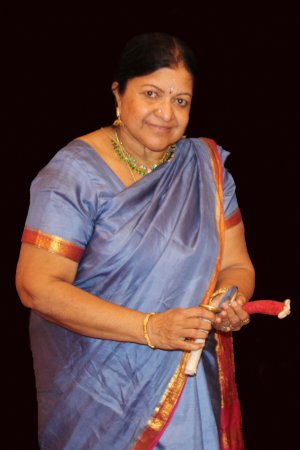 Guru Padmini Ramachandran Eesha Pinglay premiered 'Uma's Kaatha' and Sayani Chakraborty premiered 'Antar Rang' for Padmini Festival on 31st August 2024, at Mysore Association Auditorium, Mumbai. Eesha Pinglay, a senior disciple of Vaibhav Arekar, presented Uma's Kaatha, a short story by Rabindranath Tagore set in 1898 in a small town of Bengal. The story is about a little girl who aspires to read, write and learn against all odds of her era. It was a time when women's education was not given importance and child marriages were prevalent. In fact, the idea of education for women was stigmatised with superstitions. Eesha adapted this story line in her presentation. She presented the story set in 1898 and ended with a positive note on women empowerment, the need of the present times. Concept and choreography were by Eesha Pinglay, script by Pracheta Bhatt and Karthik Hebbar, who also did the music composition and vocals. Rhythms were played by Satish Krishnamurthy, flute music was handled by Mahesh Swami, light design by Sushant Jadhav and background narration was by Prachi Saathi. As the story line goes, the aspiration of the little girl named Uma to read and write was organically developed by connecting to the wonder of nature gripping her mind. The story is taken forward by showing how movements of various elements in nature like birds, animals, flora and fauna connect wide eyed and observant Uma to letters of the alphabet. She also takes inspiration to learn letters from the shadow play on walls. From learning various letters of the alphabet, she also progresses to write words, phrases, poems and stories. Basics of learning dance and music (sarali varisai) were used as analogy to help audience envisage her efforts of learning the alphabet. As she progresses to phrases and poems, analogy of higher lessons of music (thattu varisai) and dancing in double speed guided the audience to notice her progress. She prays to Goddess Kalyani with geetam, "vara veena mridu pani" (ragam Mohanam, rupakam), and requests Devi to bestow on her intelligence enabling her to read and write better. 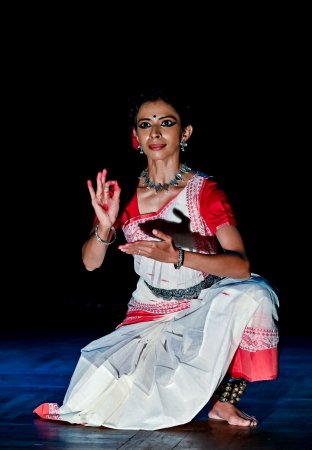 Eesha Pinglay Eesha showed very engagingly, Uma's penchant for writing as she goes about writing all over the place - on floors, trees and walls. Finally, she starts writing in available papers. One day, she finds her brother's account book and writes on it. Once her brother confronts her, she denies it. After getting her to confess her wrong doing, her brother asks her to extend her hand to accept a punishment, but he lovingly places a notebook in her hand. From then on, the book becomes her friend, "Sakhi", which she takes everywhere. She joyfully confides in it all her incidents of the day, including having eaten four sweets. She writes stories and poems in it and all facts that she finds fascinating. She dreams of being a big writer and hopes her friendship with her Sakhi (notebook) will last all through her sojourn to achieve success. The young girl is now to be married. Her parents and brother tell her to stop reading and writing for it was considered inauspicious for girls to do so. But her love for writing is very deep and can't be suppressed. She secretly takes her book with her to her marital home, all the while dreading she would be caught. She is confused even more when she is told that reading and writing would bring harm to her husband's life. The suffering and anguish she experienced due to the ban was expressed well by Eesha. All songs and jathis were now rendered in drut laya that helped to support vyabhicharis of frenzy to reach the sthayi of turmoil she was undergoing. She even expressed her need to go back to her brother's home where she could write without any worry or anxiety. Closing all windows and doors, she hides in the room to write. One day Uma is caught by her husband who angrily tears pages of the book to pieces and throws it in the air. The pain Uma undergoes was indicated as those papers falling down were not pieces of papers but her written words. The shoka rasa was felt by all. But with great determination, with an invocation to Goddess Kalyani she picks up papers and starts writing more. Just like the sun rises in the East, spreading its light in the entire world, in the same manner her voice rises through her writings spreading hope all over the world. Thus a lovely beginning in Uma's or a woman's life gets signified. Performance was done to recorded music, where Karthik Hebbar has sung very evocatively, percussion design by Satish Krishnamurthy resonated with pertinent layas, the mellifluous music flowing from the flute of Mahesh Swami stirred the audience and the lighting provided by Sushant Jadhav gave depth to the presentation. Also, narration by Prachi Saathi kept the audience on track with the story line. Surely, a stirring premiere presentation of Uma's Kaatha by Eesha Pinglay at Padmini Festival 2024. 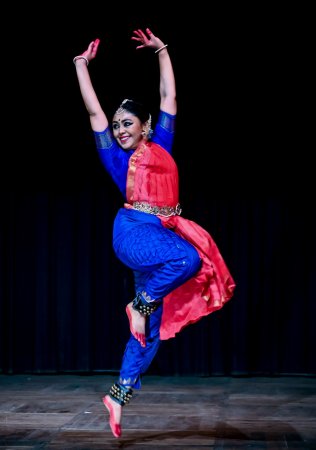 Sayani Chakraborthy Bhakti is sometimes described as a "passionate and intoxicating love" for a personal god that is "spontaneous yet cultivated through ritual and song." Sayani Chakraborthy, student of Rama Vaidyanathan, presented 'Antar Rang' - myriad hues, a theme based on devotion and love to Lord Krishna with motif of rain where he makes his presence felt in showers from the rain-bearing clouds. The presentation was a showcase of three pieces. One depiction was Meerabai's yearning for union with the divine soul, other was Radha waiting for her union with the Lord and third was a tarana presenting rain as it brings freshness and joy all around. Conceptualisation and choreography were by Sayani Chakraborthy, music composition by Dr. Durbha Singh Roy Choudhury, jathis by N Shankar and swaram inputs by Keertana Krishnamurthy and on lights was Lakshmi. Meerabai in her bhajans not only talks about Lord Krishna as her beloved but also about her own self which passionately longs for spiritual union with God. Bringing forth the image of 'Meerabai with her ektara', dancing and regaling us, Sayani interpreted visual images ingrained in verses of Meerabai's bhajan, "Hari aawan ki awaaz" (Ragamalika, adi), with creative imagination. Bhajan presentation was moulded into varnam format of Bharatanatyam. As clouds gather in the sky, Krishna stands poised, his flute at his lips. Reverberating sound of the flute fills the air, reaches deep within Meera and awakens her passion to see her Lord. It is also a sign that her Lord is coming to her. She first connects to him by decorating his idol, enjoying each of his adornments. Expressing that she is caged in this prison of wealth and luxury, where her solution to get free of those is to focus on her spiritual marriage to Krishna, she enquires when he would come. The twittering of birds leads her to presence of rain-bearing clouds that represent the image of Krishna. And with their excited flying, she too gets restless and her yearning is intensified. Meerabai's poems are at once spiritual and sensual. Though she expresses her love for Krishna in a sensual manner, her love is profoundly spiritual. In the line "barse boondan megha bole damini chodi laaj" Sayani demonstrated in an engaging manner how Meerabai enjoyed raindrops that fell on her various limbs, drenching not in the falling rain but love of Krishna. In "Piya milan ki aas", the lighting work on Sayani featuring as Krishna showed he had come, all-pervading and encompassing the space. With the metaphor, that earth is adorned with new freshness and growth, work of rains, Meera says everything is soaked with overwhelming love of Krishna. Finally, completing her song with visual imagery of embracing Krishna, she sits back with the ektara. Nritta patterns set for jathis were performed in a power-packed manner covering great space. In the jathis and korvais, the cadences of movements taken from originally designed adavus were interspersed with lighter cadences of movements that at times held inverted hastas, and Nataraj/ Parvati like poses and abhinaya too was linked to them. The cadences of movements like high jumps, turns, and twists, showing influence of ballet training, were added in the nritta patterns. The nritta combinations at times gave the illusion of a new adavu. After finishing the ardi, Sayani connected back to the sahitya of the bhajan with the image of Meera taking her ektara in hand. Soulfully sung by Keertana Krishnamurthy in neraval format of the classical Carnatic music form, here phrases instead of lines got repeatedly rendered; the bhajan was sung in raag Malhar and echoes of different Malhars were given to associate with emotions portrayed. Hence regarded as a Raagamalika composition, it was a visual and aural treat. Ashtapadi composed by Jayadeva (12th century) depicts the separation and eventual reunion of the eternal lovers, Radha and Krishna. The range of hues in which Jayadeva depicts the character of Radha in Gita Govinda, as a woman with real emotions, is truly mesmerizing. Though Radha is a vipralabdha nayika, Jayadeva presents Radha as a very noble lover. She is aware that Krishna frolics with other gopis of Vrindavan but by remembering numerous virtues of her Lord, she cannot help loving him more. Convincingly, Sayani presented Radha lamenting to her Sakhi, Krishna's delay in meeting her, in the 13th ashtapadi "Yami he" (Ragamalika, adi). Radha is waiting for Krishna to arrive. Seeing the moon has risen high, she asks her friend when Krishna would arrive. He has not come to Vrindavan at the promised time. Has Krishna forgotten her? Her youth is fading like the garland losing its freshness. Besides she has to listen to others who speak degradingly about her. She is waiting all dressed up checking herself again and again in the clear waters of the Yamuna. But he hasn't shown up and she is distressed as she perceives that all her beauty has gone in vain. She shows her anger and disappointment by splashing the water and disturbing her mirror image in the water. She is tired of looking for Krishna in the forest. As she is giving up her search, she hears the flute music reverberating. Suddenly she realises that the music is alive in herself, filling up her very existence and her heart beats with joy. And she feels as if Manmatha is shooting flower arrows at her, but in reality, they are flowers falling from trees at night. She realises he is perhaps regaling with other Gopis and enquires again if he has forgotten her. In the end, despite her Sakhi trying to counsel her and take her away, she holds on to the faith that he would come. The vipralabhdha she is, she does not lose hope and continues to wait for her Lord. Tarana (Behaag, adi) was entwined with jathis and swarams and a bandish attached for the lyrical aspect, presenting a deviation from the normal thillana format of Bharatanatyam. Keeping with the subject matter of rains, with a crisp entry, Sayani depicted rain-bearing clouds and rainbow. Rendering elements of thillana format, attami and eye movements that usually depict joy or delight, took form of expressions of shyness. Mei adavus that follow were modified to suit features of a rainy day environment - opening of doors and windows to witness the rainfall with joy, trees growing from the ground, catching water in the hand, splashing water with legs and flowering of flowers. Each jathi rendered, took a form - the peacock fanning its feathers, deer leaping with joy, trees swaying in harmony and the human joy when they embrace the rain. Finally, a korvai, where after a few adavu combinations, the deer, peacock, tree and she representing human form are juxtaposed together - all drenching in rain become one with nature. Thus, the Tarana celebrated the rhythm of monsoon and nature's vibrant beauty, where every heartbeat echoes the pulse of rain and every soul dances in unison with the earth. Sayani had superb music support from the live ensemble with Keertana Krishnamurthy on the vocals, Dr. Himanshu Srivastava on nattuvangam, Prajesh Nair on mridangam and Vivek Anantaram on flute. Owing to the dreamlike quality of the pace and lighting effects that enhanced the visual quality, the presentation was an aural and visual treat. 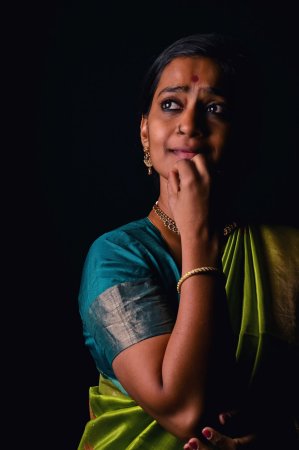 Keerthana Ravi Keerthana Ravi (curator of Padmini and Evam festivals) is one of the leading pioneers of "Pay for arts" campaign. She curated Evam festival - India's first crowd funded classical dance festival in 2016 in Mumbai. Her vision is to make classical arts more sustainable by ensuring financial viability as a performing artiste. This idea helped in maintaining the high quality of classical dance performance as only talent will bring in the audience. This also becomes another choice between reaching out for a movie, a play or stand-up show over the weekend, as high standards of art form assures people of spending quality time in the performing arts scenario. Thus, the initiative to promote and popularize Indian classical dance and music in the country becomes narrowed down to talent and people's choice achieving a sure success to sustain our Indian culture in our country. 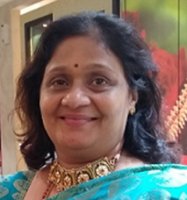 Chandra Anand is a Bharatanatyam artiste and teacher. She has an MA in Bharatanatyam from Tilak Maharashtra Vidyapeeth, and her series on 'Education in spiritual values through Bharatanatyam' is featured in narthaki.com. |